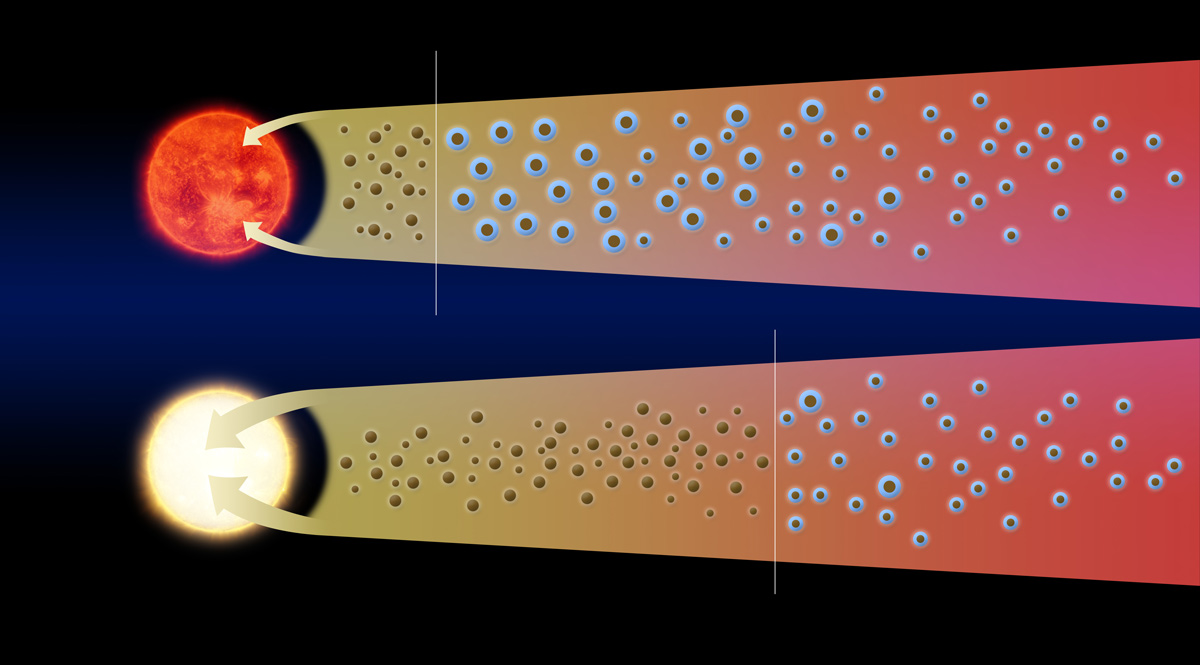Astronomers have been able to observe a star's snow line - the point where the water vapour surrounding a stellar body becomes snow and ice - for the first time ever.
Usually, that boundary is so close to a star that astronomers aren't able to see it, but a sudden burst of brightness pushed the snow line in this young solar system far enough out that it could be detected from here on Earth. You can see the boundary in the artist's impression above.
This is a big deal for astronomers, because it could help us understand more about how planets form - water ice regulates how dust grains clump together, and those clumps form the basis of comets, in addition to ice giants such as Neptune, plus the giant cores that are suspected to reside inside gas giants like Jupiter.
When stars are first born, they're surrounded by a whole lot of gas, dust, and debris - and from that disk of rubble, all of the planets that end up orbiting it will be formed.
In the early days while stars are still heating up, they're usually only hot enough to evaporate water in the disk up to about 450 million kilometres (280 million miles) away - which sounds like a lot, but is still too close for telescopes here on Earth to make out.
(FYI, in space, water skips its liquid phase because of the extremely low pressure.)
But the star in question, V883 Orionis, which is located around 1,350 light-years from Earth in the Orion constellation, is going through a particularly hot flash, after some of its gassy disk appears to have fallen into it, stoking its fire.
As a result of all this extra heat, the star has vaporised water all the way out to 6 billion kilometres (3.7 billion miles) away - the average distance at which Pluto orbits the Sun.
Which meant that researchers could detect the ice/vapour boundary, or snow line, for the first time, using the Atacama Large Millimetre/submillimetre Array (ALMA) in Chile. The international team has published their results in Nature.
In the illustration below you can see the comparison between the regular snow line (above) and new snow line (below):
 ALMA/L. Cieza
ALMA/L. Cieza
The researchers only happened to be looking at the star in order to image disk fragmentation, so were pretty surprised to instead detect the snow line itself.
"The ALMA observations came as a surprise to us," said lead researcher Lucas Cieza, an astronomer at Diego Portales University in Chile.
"The distribution of water ice around a young star is fundamental to planet formation and even the development of life on Earth," added one of the team members, Zhaohuan Zhu, from Princeton University. "ALMA's observation sheds important light on how and where this happens in protoplanetary disks when young planets are still forming."
Water ice is so important for planetary formation, because astronomers think that it influences the types of planets that can form, and where.
Inside the snow line, where water is vaporised, astronomers hypothesise that the conditions favour the formation of smaller, rocky planets, like Mars and Earth. And outside the water line, all that ice makes it easier for cometary bodies, ice giants, and also gas giants, such as Jupiter.
"Since water ice is more abundant than dust itself beyond the snow line, planets can aggregate more solid material and form bigger and faster there," said Zhu. "In this way, giant planets like Jupiter and Saturn can form before the protoplanetary disk is gone."
That fits with our understanding of how our own Solar System formed, but up until now we haven't known whether the same thing happens around other stars.
"The fact that the location of the snow line can evolve with time has strong implications for planet formation," Brenda Matthews, an astronomer from the National Research Council of Canada, who wasn't involved in the study, wrote in a News & Views column accompanying the paper.
The results "would confound models that predict the slow formation of rocky planets within the snow line, and rapid gas-giant formation outside it," she added.
We still have a lot to learn about how planets form from the dust and gas around stars, and there's a lot more research to be done on the importance of the water line. But we just got a big step closer to understanding the process.
"We now have direct evidence that a frosty region conducive to planet formation exists around other stars," said Zhu.
